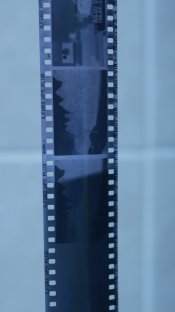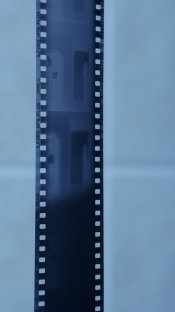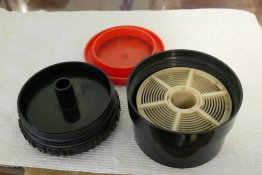Hello all. Another noob mistake all of you could help me diagnose. This has happened to me twice already, so clearly it is a trend and not just a fluke. When I develop a roll of film the first frame looks half properly developed and half very dark, like the short length of film after the leader, as if I had accidentally exposed it (picture below). However I load the camera just as the Nikon manual suggests:
Also I noticed another such uneven (development?) line in roll # 2 shown in the second picture. This roll has TWO such lines. What is going on here?
Finally I see my rolls are starting at frame # 2 and end in frame # 25 (have only been using 135-24 film so far). Is this normal? Seems I could have a whole 'nother frame if only I load it properly! Better yet I see another two frames worth of film in front of frame # 1...yet another 2?! These could in theory be exposed as the two dots in the beginning of the film counter S . . 1.
Well anyway, I guess I will be having to load my next roll in a darkroom bag for now until I can figure this out.
- After fully winding previous roll into cartridge, push little button around film winding crank wheel and pull crank wheel out to open back. (Never had "extra film" sticking out of the cartridge when the camera is opened yet.)
- Remove previous cartridge and place new one in. Push winding crank wheel all the way in to hold cartridge in place.
- Pull some film out. Just enough to put a bit of the leader into the slot of the take-up spool. Turn take-up spool a little so as to begin to roll film onto spool. Once the take-up spool has begun to "grip" the film a bit I will hold down the film near the mouth of the cartridge while continuing to wind the take-up spool to take out the slack wile not pulling any more film out of the cartridge. I really try to minimize how much film is pulled out of the cartridge before closing the back.
- Close the back when the film is reasonably taunt and flat.
- Pull the film advance lever and push the shutter button a few times until the film counting dial goes from "S" to "1."
Also I noticed another such uneven (development?) line in roll # 2 shown in the second picture. This roll has TWO such lines. What is going on here?
Finally I see my rolls are starting at frame # 2 and end in frame # 25 (have only been using 135-24 film so far). Is this normal? Seems I could have a whole 'nother frame if only I load it properly! Better yet I see another two frames worth of film in front of frame # 1...yet another 2?! These could in theory be exposed as the two dots in the beginning of the film counter S . . 1.
Well anyway, I guess I will be having to load my next roll in a darkroom bag for now until I can figure this out.





 You never quite know what you're going to get.
You never quite know what you're going to get. ?
?